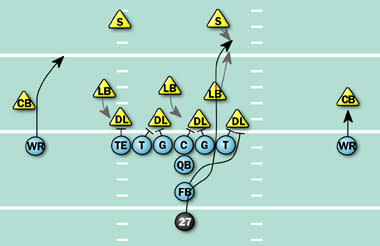Jacobs needs to reassert powerful presence
Also in this article:
Next Surveillance:
Falcons
More NFL:
Editor's note: Yahoo! Sports will examine the biggest weakness of the 2009 season for every team and explain how the franchise can address the issue. The series continues with the Giants, who finished third in the NFC East (8-8).
Biggest problem in 2009: Jacobs' power loss

Brandon Jacobs(notes) rushed for 835 yards and 5 touchdowns in '09.
(US Presswire)
The New York Giants had two problems that kept them out of the playoffs for the first time since 2004: a defense that suffered a severe downturn from the one that helped them win Super Bowl XLII, and a rushing attack that lost almost all of its power. It's thought that the defensive issues will be solved with three additions: new coordinator Perry Fewell, first-round defensive end Jason Pierre-Paul(notes), and big-time free-agent safety Antrel Rolle(notes). The rushing attack is a more complicated matter.
The "Earth, Wind and Fire" trio of Brandon Jacobs, Ahmad Bradshaw(notes), and Derrick Ward(notes) was reduced to an inconsistent duo. With Ward in Tampa Bay, Bradshaw got more carries and took advantage with his best season to date. Still, that left him with 778 rushing yards and just two games with 100 or more yards on the ground. Even worse, Jacobs, the main man, experienced an alarming drop in power and production.

Bradshaw
Jacobs signed a new four-year contract with the Giants in February of 2009 after an '08 season in which he set then-career highs in carries (219), rushing yards (1.089), 100-yard games (four) and rushing touchdowns (15). It was the second straight season in which he had gained five yards per carry, and though he was bothered all season by a knee injury, that's part of physical style – Jacobs has dealt with different nicks throughout his career. With a more featured role, Jacobs had high expectations put on him for 2009.
Safe to say, those expectations were not met. Jacobs, formerly one of the league's best power backs, started hesitating at the line, and the effects were immediate. Jacobs gained just 835 yards on 224 carries, had no 100-yard games, and scored just five rushing touchdowns. More than one analyst questioned Jacobs' ability to run between the tackles, but the man himself remained unconcerned. "I feel like I'm running the same way I was running [in 2008]," Jacobs told the New York Daily News in early October. "Getting a little bit smarter, being patient, let the scheme happen for me. You just can't run in there and think that you can outrun your blocks."
The 2010 solution: Get back to basics
The nadir of Jacobs' hesitant style came in Week 16, when he ran six times against the Panthers for a grand total of one yard. One week before, Jacobs put up just 52 yards on 16 carries against the Redskins, exhibiting all the negative characteristics he'd displayed all year, hesitating at the line and looking slow on pitches outside. His longest run was for 10 yards, leaving him with 2.8 yards per attempt on his 15 other carries. Meanwhile, Bradshaw had taken over as the goal-line back, scoring on three- and four-yard runs in the Giants' 45-12 victory. Perhaps most disturbing was that on many of these plays, the Giants went with I-formation and a tight end, giving Jacobs seven blockers.

The Giants faced the Panthers in Week 16 of the 2008 season as well, and it was a very different Jacobs (27) who ran 24 times for 87 yards and three touchdowns. With five minutes left in the first quarter and the Panthers up 7-3, the Giants lined up in an I-formation at their own 40-yard line (illustration). It's important to note how similar Jacobs' roles looked from 2008 to 2009 – as the inside rusher, the occasional point man in a power sweep, and heading upfield on play action. He ran much more effectively inside out of I-formation in 2008, and this 10-yard play was a primary example. The Panthers went with a base 4-3, and the Giants countered with a great combination of blocking assignment-correctness and quick reads by their running back. Both defensive tackles were double-teamed, breaking Carolina's power advantage. As right tackle Kareem McKenzie(notes) moved to the second level to box out the weak-side linebacker, fullback Madison Hedgecock(notes) took the left end and kept him out of the play. Meanwhile, Jacobs took the ball from Eli Manning(notes) and immediately bounced up and off right guard Chris Snee(notes), and broke two open-field tackles in the clear. In direct contrast to his 2009 style, the decisiveness Jacobs showed on this and other plays was outstanding.
While there may be a slight downturn in the quality of the Giants' offensive line, the numbers don't point to this kind of faceplant – the 2009 line was down about half an adjusted line yard per carry from the 2008 version, and the team went with basically the same repertoire of pulls, traps, and counters that forged one of the league's better lines in recent years. If the Giants want to get back to power running the right way, they must recalibrate their expectations of Jacobs. He is a productive back, but not an especially versatile one – his skill set revolves around reading quick gaps, cutting up the field, and making prospective tacklers pay.
